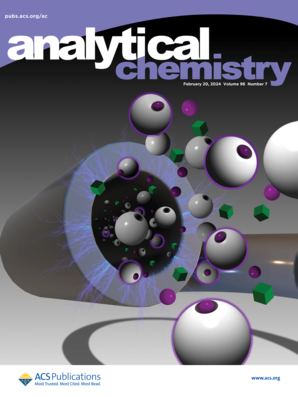用于表面增强拉曼光谱和蛋白质吸附抑制的等离子滑动表面
IF 6.7
1区 化学
Q1 CHEMISTRY, ANALYTICAL
引用次数: 0
摘要
本文章由计算机程序翻译,如有差异,请以英文原文为准。

Plasmonic Slippery Surface for Surface-Enhanced Raman Spectroscopy and Protein Adsorption Inhibition
Slippery liquid-infused porous surfaces (SLIPSs) are a class of surface that offers low contact angle hysteresis and low tilt angle for water droplet shedding. This property also endows the surface with pinning-free evaporation, which in turn has been exploited for analyte concentration enrichment for Surface Enhanced Raman Spectroscopic applications and antibiofouling. Herein, we demonstrate a facile approach for creating SLIPS with low contact angle hysteresis and low tilt angle for water shedding by coating the equal-volume mixture of polydimethylsiloxane (PDMS) and silicone oil. By exploiting the in situ plasmonic particle reduction capability of the PDMS, the surface is converted to plasmonic SLIPS, which illustrates its potential as a sensitive analytical platform via surface-enhanced Raman spectroscopy. The Raman spectroscopic studies using crystal violet as a reference sample show a limit of detection of 76 pM. Further, we have demonstrated that the fabricated plasmonic substrate is found to be more efficient in inhibiting proteins (bovine serum albumin) on the surface compared to pristine PDMS surfaces. Our fabricated plasmonic surface can find applications in ultrasensitive molecular detection for applications related to analytical chemistry, diagnostics, environmental monitoring, and national security and more importantly can control the nonspecific adsorption of proteins.
求助全文
通过发布文献求助,成功后即可免费获取论文全文。
去求助
来源期刊

Analytical Chemistry
化学-分析化学
CiteScore
12.10
自引率
12.20%
发文量
1949
审稿时长
1.4 months
期刊介绍:
Analytical Chemistry, a peer-reviewed research journal, focuses on disseminating new and original knowledge across all branches of analytical chemistry. Fundamental articles may explore general principles of chemical measurement science and need not directly address existing or potential analytical methodology. They can be entirely theoretical or report experimental results. Contributions may cover various phases of analytical operations, including sampling, bioanalysis, electrochemistry, mass spectrometry, microscale and nanoscale systems, environmental analysis, separations, spectroscopy, chemical reactions and selectivity, instrumentation, imaging, surface analysis, and data processing. Papers discussing known analytical methods should present a significant, original application of the method, a notable improvement, or results on an important analyte.
 求助内容:
求助内容: 应助结果提醒方式:
应助结果提醒方式:


